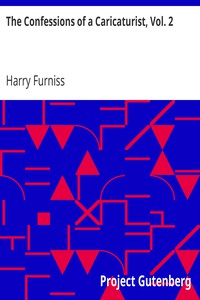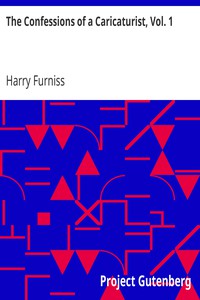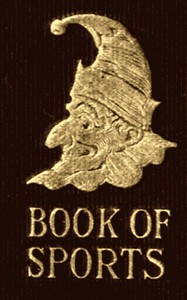The Confessions of a Caricaturist, Vol. 2, Harry Furniss [affordable ebook reader txt] 📗

- Author: Harry Furniss
Book online «The Confessions of a Caricaturist, Vol. 2, Harry Furniss [affordable ebook reader txt] 📗». Author Harry Furniss
"In fact, London had never seen anything so original as Harry Furniss's Royal Academy. The work of one man, and that man one of the busiest professional men in town. Indeed it might be thought that at the age of thirty, with all the foremost magazines and journals waiting on his leisure, with a handsome income and an enviable social position assured, ambition could hardly live in the bosom of an artist in black and white. Unlike Alexander, our hero did not sit down and weep that no kingdom remained to conquer, but set quietly to work to create a new realm all his own. His Royal Academy, although presented by himself to the public as an 'artistic joke,' showed that he could not only use the brush on a large scale, but that he could compose to perfection, and after the exuberant humour of the show, nothing delighted[Pg 3] and surprised the public more than the artistic quality and finished technique in much of the work, a finish far and away above the work of any caricaturist of our time."

T
HE idea first occurred to me at a friend's house, when my host after dinner took me into the picture gallery to show me a portrait of his wife just completed by Mr. Slapdash, R.A. It stood at the end of the gallery, the massive frame draped with artistic care, while attendants stood obsequiously round, holding lights so as to display the chef d'œuvre to the utmost advantage. As I beheld the picture for the first time I was simply struck dumb by the excessively bad work which it contained. The dictates of courtesy of course required that I should say all the civil things I could about it, but I could hardly repress a smile when I heard someone else pronounce the portrait to be charming. However, as my host seemed to think that perhaps I was too near, and that the work might gain in enchantment if I gave it a little distance, we moved towards the other end of the gallery and, at his suggestion, looked into an antiquated mirror, where I got in the half light what seemed a reflection of it. The improvement was obvious, and I told my friend so. I told him that the effect was now so lifelike that the figure seemed to be moving; but when he in turn gazed into the glass he explained somewhat testily that I was not looking at his wife's portrait at all, but at the white parrot in the cage hard by. The moral of this incident is that if patrons of art in their pursuit of eccentricities will pay large sums to an artist for placing a poor portrait in a massive frame with drapery hanging round it in the most approved modern style, and be satisfied with such a result, they must not be surprised if a parrot should be mistaken for a framed type of beauty. I was, however, not satisfied until I had examined the picture in question closely and honestly in the full light of day, when I saw that Mr. Slapdash, R.A., had sold his autograph and a soiled canvas in lieu of a portrait to my rich but too easily pleased friend.[Pg 4]
As I walked back into the drawing-room, one of the musical humorists of the day was cleverly taking off the weak points of his brother musicians, and bringing out into strong light their peculiarities and faults of style. The entertainment, however, did not tend to raise my drooping spirits, for I was sad to think how low our modern art had sunk, and with a heavy heart and a sigh for the profession I pursue, I went sadly home. Of course my pent-up feelings had to find relief, so my poor wife had to listen to an extempore lecture which I then and there delivered to her on portraiture past and present—a lecture which I fear would hardly commend itself to the Association for the Advancement of British Art. Further, I asked myself why should I not take a leaf out of the musical humorist's book and like him expose the tricks and eccentricities of British art in the present day?
The following morning, being a man of action as well as of word, I started my "Artistic Joke." I was determined to keep the matter secret, so I worked with my studio doors closed, and as each picture was finished it was placed behind some heavy curtains, secure from observation, and I kept my secret for three years, until the work was complete.
I soon found that I had set myself a task of no little magnitude. Before I could really make a start I had to examine each artist's work thoroughly. I studied specimens of the work of each at various periods of his or her career. I had to discover their mannerisms, their idiosyncrasies and ideas, if they had any, their tricks of brushwork, and all the technicalities of their art. Then I designed a picture myself in imitation of each artist. In a very few instances only did I parody an actual work. This fact was generally lost sight of by those who visited the Exhibition. The public imagined that I simply took a certain picture of a particular artist and burlesqued it. I did this certainly in the case of Millais' "Cinderella" and one or two others; but in the vast majority of the works exhibited, even in Marcus Stone's "Rejected Addresses," which appeared to so many as if it must have been a direct copy of some picture of his, the idea was entirely evolved out of my own[Pg 5] imagination. In thinking out the various pictures I devoted the greatest care to accuracy of detail. I was particular as to the shape of each, and even went so far as to obtain frames in keeping with those used by the different artists. Of course it was out of the question for me to do the pictures in colour, which would have required a lifetime, and probably tempted me to break faith with my idea; not to mention the fact that I should in that case most likely have sent the collection to the Academy, of which obtuse body, if there is any justice in it, I must then naturally have been elected a full-blown member.
 THROWING MYSELF INTO IT.
THROWING MYSELF INTO IT.
In order to get the Exhibition finished in time, I often had to work far into the night, and on one occasion when I was thus secretly engaged in my studio upon these large pictures until the small hours, I remember a catastrophe very nearly happened which would have put a finishing touch of a very different kind to that which I intended, not only to the picture, but to the artist himself. It happened thus. About three o'clock in the morning, long after the household had retired to rest, I became conscious of a smell of burning. I made a minute search round the studio, but could not discover the slightest indication of an incipient conflagration. Then a dreadful thought occurred to me. Beneath the studio is a vault, access to which is gained by a trap-door in the floor. Could it be that the secret of my "Artistic Joke" had become common property in the artistic world, and that some vindictive Academician, bent upon preventing the impending caricature of his chef d'œuvre, was even now, like another Guy Fawkes, concealed below, and in the dead of night was already commencing his diabolical attempt to roast me alive in the midst of my caricatures? Up went the[Pg 6] trap-door, and with candle in hand I explored the vault. The result was to calm my apprehensions upon this score, for there was no one there. Still mystified as to where the smell of fire, now distinctly perceptible, came from, I next walked round the outside of my studio, exciting evident suspicion in the mind of the policeman on his beat. No, there was not a spark to be seen; no keg of gunpowder, no black leather bag, no dynamite, no infernal machine. I returned into the house and went upstairs, roused all my family and servants, who, after a close examination, returned to their beds, assuring me that all was safe there, and half wondering whether the persistent pursuit of caricaturing does not produce an enfeebling effect upon the mind. Consoled by their assurances, I returned once more to my studio, where the burning smell grew worse and worse. However, concluding that it was due to some fire in the neighbourhood, I settled down to work once more; but hardly had I taken my brush in hand when showers of sparks and particles of smouldering wood began to descend upon my head and shoulders, and cover the work I was engaged on. I started up, and looking up at my big sunlight, saw to my horror that I had wound up my easel, which is twelve feet high, and more nearly resembles a guillotine than anything else, so far that the top of it was in immediate contact with the gas, and actually alight!
 FIRE!
FIRE!
The Times took the unusual course of giving, a month in advance of its opening on April 23rd, 1887, a preliminary notice of this Exhibition.
It said: "A novel Exhibition, for which we venture to[Pg 7] prophesy no little success, is being prepared by Harry Furniss of Punch celebrity. As everyone knows, Mr. Furniss has long adorned the columns of our contemporary with pictorial parodies of the chief pictures of the Royal Academy, the Grosvenor, and other shows, and it has now occurred to him to develop this idea and to have a humorous Royal Academy of his own. He has taken the Gainsborough Gallery in Old Bond Street, which he will fill some time before the opening of Burlington House with a display of elaborate travesties of the works of all the best known artists of the day. There will be seventy pictures in black and white, many of them large size, turning into good-natured ridicule the works of every painter, good and bad, whose pictures are familiar to the public," etc., etc. This gives a very fair idea of the nature and objects of my "Royal Academy." My aim was to burlesque not so much individual works as general style, not so much specific performances as habitual manner. As an example I take the work of that clever decorative painter and etcher, Mr. R. W. Macbeth, A.R.A. By his permission I here reproduce reductions in black and white of three of his well-known pictures, and side by side I show my parody of his style and composition—not, as you will observe, a caricature of any one picture, but a boiling down of all into an original picture of my own in which I emphasise his mannerisms. Furthermore, in my catalogue I parodied the same artist's mannerism in drawing in black and white, and with one or two exceptions





Comments (0)